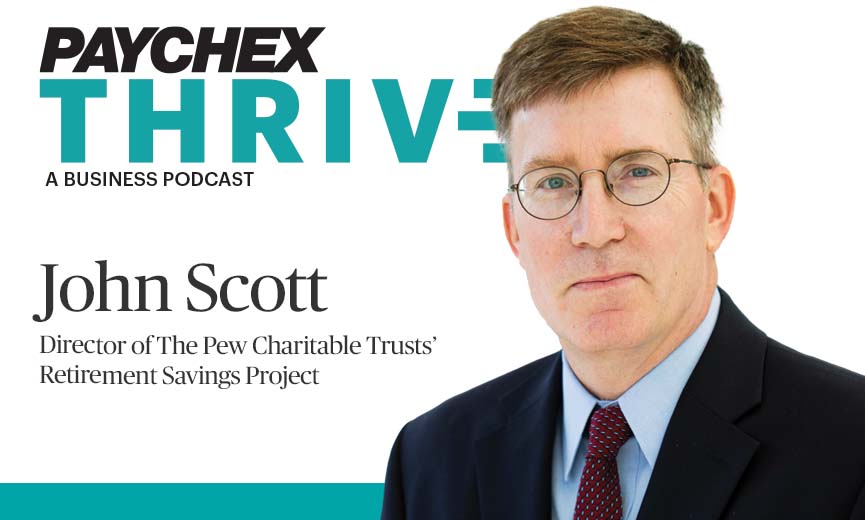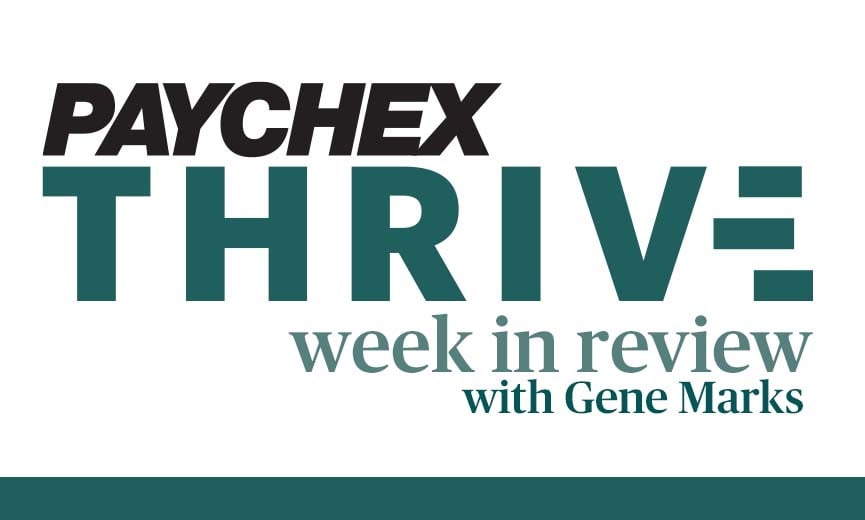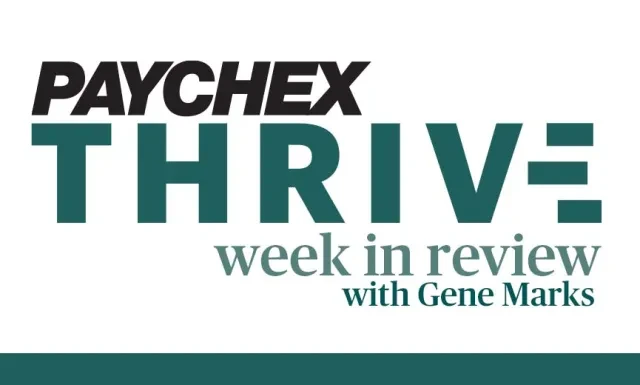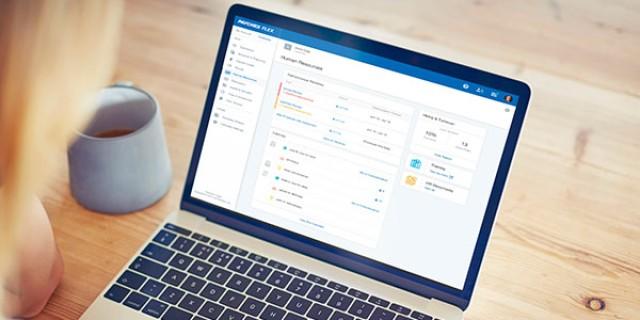Zachary Keep de Paychex: Cómo la Ley SECURE 2.0 puede beneficiar a su negocio
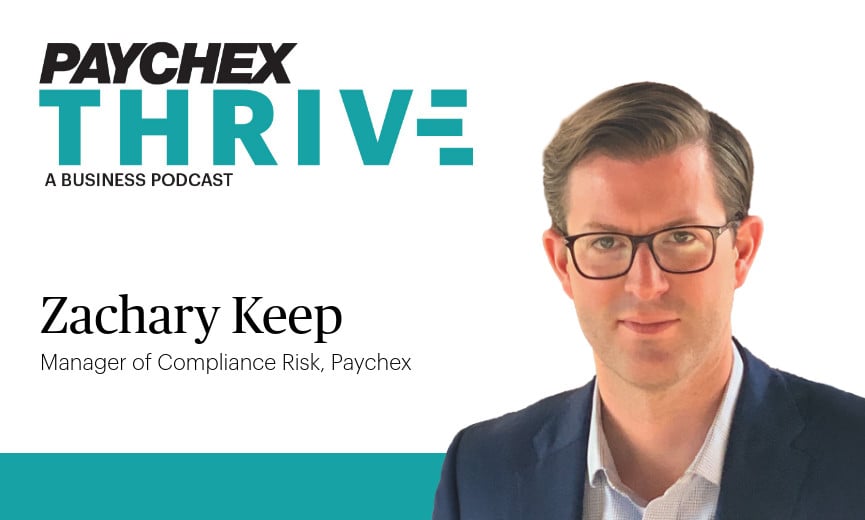
Podcast •

Vea
Resumen
Is your business capitalizing on SECURE Act 2.0? On this episode of THRIVE, Gene sits down with Zachary Keep, Manager of Risk Compliance at Paychex, to unpack the game-changing potential of SECURE 2.0. From tax credits that make setting up a 401(k) basically free to the introduction of auto-enrollment, this legislation is transforming how small businesses attract and retain employees.
Topics include:
00:00 – Episode preview and welcome
01:12 – What is SECURE Act 2.0?
02:45 – SECURE 2.0 incentives for employers
03:12 – Tax credits for new retirement plans
05:22 – Matching contribution incentive structure
06:42 – New auto-enrollment rules
07:58 – Automatic escalation explained
09:31 – Rothification of catch-up contributions
11:51 – State mandated retirement plans
14:21 – SECURE 2.0 key takeaways
15:14 – Wrap up and thank you
12 retirement trends you need to know for 2025.
Regulatory changes every business should prepare for this year.
Ver transcripción
Gene Marks (00:00)
Hey, everybody, it's Gene Marks. I just had a great conversation with Zach Keep. Zach is a Risk Compliance Manager at Paychex and we talked about SECURE 2.0. If you're running a business, offering good retirement plans is a real competitive advantage to attract people to your business as well as retain good talent. SECURE 2.0 is legislation that passed a couple years ago, and some things are happening this year that's going to impact your business. Zach went over some of the things that are taking place this year as well as giving us a good overview of what SECURE 2.0 is and how you can use it to your advantage in your business. So, I really think you're going to enjoy this conversation. Let's get right to it.
Announcer (00:40)
Welcome to Paychex THRIVE, a Business Podcast where you'll hear timely insights to help you navigate marketplace dynamics and propel your business forward. Here's your host, Gene Marks.
Gene Marks (00:57)
So, Zach Keep, thank you very much for joining me today.
Zachary Keep (01:00)
Thank you so much, Gene. Good to be here.
Gene Marks (01:02)
We are talking about retirement. We're talking about SECURE 2.0. So, we're now early in 2025. Tell us what we need to know as employers. What do we need to know?
Zachary Keep (01:12)
Right, as employers, particularly as small employers, SECURE 2.0 is the story. It's been the story for a couple of years and it's going to be the story for at least a few more years. You know, we always joke in the retirement industry, SECURE keeps our jobs secure. Because Even though SECURE 2.0 is a couple of years old now, you know, we were reading those provisions as Christmas music was playing not too long ago. But the impact of this landmark piece of legislation continues to be felt.
Gene Marks (01:41)
I'm going to interrupt you and ask you just to take one step back for our viewers and listeners that might not be familiar with what SECURE 2.0 is. Sure, just a two-minute history of the legislation.
Zachary Keep (01:52)
Great question. So SECURE, it's an acronym. Look, like every piece of legislation, it's setting every community up for retirement. There's two secures, there's the SECURE Act of 2019, and then there's what we call SECURE 2.0, 2023. SECURE 1.0 did a lot of interesting things. It created pooled employer plans. It established some incentives for employers to offer a 401(k) for the very first time, and a lot of administrative things. But this was a very successful period piece of legislation. It drove plan establishment, it excited a lot of people about 401(k) retirement in general, and it very quickly led to SECURE 2.0. SECURE 2.0 is just monumental in scale. Obviously, I'm a retirement nerd, but you know, it's almost like the FDR style New Deal of retirement. It really does change everything.
Gene Marks (02:45)
And the idea here is, you know, we have a retirement crisis in this country. Not enough people are putting money, money away for retirement. So, you know, the government is like, okay, we want to give incentives employers and to individuals to save for retirement.
Zachary Keep (02:58)
Right. So, let's talk about that.
Gene Marks (02:59)
Go ahead.
Zachary Keep (03:00)
SECURE 2.0 built on 1.0 and I mentioned earlier, it tried to incentivize plan establishment for employers. It tried to incentivize that through the use of tax credits.
Gene Marks (03:12)
Right.
Zachary Keep (03:13)
So SECURE1.0 said, hey, employer, you offer a new plan, usually a 401(k). You know, there's other types out there, but 401(k) is what most people talk about. So, you offer a new 401(k), we're going to allow you to claim up to 50% of your startup cost as a tax credit. Good thing.
Gene Marks (03:30)
Yep.
Zachary Keep (03:31)
SECURE 2.0 upped that, brought it up to 100% of startup costs. So, as a new employer today setting up that 401(k) plan, it's, I don't want to say it's free, it's obviously essentially free, but essentially a lot of those startup costs are going to be offset for any employer with 50 or fewer employees. And if you're a slightly larger employer in that 50 to 100 space, you can still claim half of those startup costs.
Gene Marks (03:58)
Got it.
Zachary Keep (03:59)
So, it's substantially offsetting that initial, I don't want to say sticker shock almost, but it's offsetting that cost. Also with SECURE 2.0, and this was very interesting, no one was expecting this. Not just is there an incentive to establish a plan, there's an incentive to establish a fully featured plan. And what Uncle Sam is doing is trying to encourage employers to, yeah, offer the plan. Also offer that employer match. We all know about employer matching contributions. Almost all 401(k)s have them in the larger business space. But when we look at the smallest employers, that's not so much the case. So SECURE 2.0 said, okay, offer your plan, get your startup credits, but offer that match for the first two years, you can offset your employer contributions up to $1,000 per employee. And it's going to be phased out over time. It's not a permanent offset, but 100%, 100% in years one and two. 75%, 50%, 25%. So, for the first five years of that new plan, the employer who contributes to their employees 401(k) is able to kind of not have any downside to that.
Gene Marks (05:22)
So, you know what this is really attempting to do, SECURE 2.0 is first of all making it almost free through the tax credits to set up a 401(k) plan. So, whenever you speak to, whenever I speak to a business owner that doesn't have a 401(k) plan in their business, like why wouldn't you? I mean, the government will essentially pay you to set one up. And by the way, I mean, when you're trying to recruit talent and retain talent, I mean, having retirement plan is kind of a competitive thing that you need to have.
Zachary Keep (05:48)
Right. And even beyond that, not just a retirement plan, but a retirement plan that does things like offer employer matching contributions.
Gene Marks (05:54)
Exactly right. So that was the second big thing. Well, if I have a 401(k) plan set up, then I'm going to have to, you know, contribute. You don't have to contribute or match your employees’ contributions. But that is again a competitive thing to do. And the government is basically saying, hey, good...
Zachary Keep (06:06)
We're going to make it easy.
Gene Marks (06:08)
We're going to make it easy. We are going to reimburse you for doing it again through tax credits to, you know, to make those contributions. So those are two. There are many other parts of SECURE 2.0.
Zachary Keep (06:17)
Absolutely.
Gene Marks (06:18)
That you know, encourage employers to have more participation 401(k) plans. And I also want to also say, before I ask you about auto-enrollment, let's not forget that the more employees that you have participating in a 401(k) plan, the more that they contribute to a 401(k) plan, the more that you, as the employer, can contribute to the 401(k) plan without failing some of those discrimination tests.
Zachary Keep (06:41)
Exactly.
Gene Marks (06:42)
Which gets me to auto-enrollment. So, this year a new thing takes place under the SECURE 2.0 legislation. Talk to me about that.
Zachary Keep (06:49)
Absolutely. So, auto-enrollment, I think when we're having this conversation at another podcast 10 years from now, we're going to look back and say, wow, auto-enrollment changed the face of employer sponsored retirement plans. Because historically, if I wanted to take part in my Paychex 401(k) when I was a new employee here, I had to go online, I had to set up my account, I had to select my deferral amount.
Gene Marks (07:12)
Right.
Zachary Keep (07:13)
And in practice, not everyone does that. There are statistics out there, but we know a substantial minority of employees just never get around to it. They're not confident in how to do it, they're nervous about it. They say, oh, I'll get to it tomorrow and tomorrow and tomorrow and tomorrow and it just never happens. And then they're looking at retirement and they don't have the assets that they could have had. So SECURE 2.0 changed it to an opt out arrangement. Not for everybody. There's some, some particularities with this. But effectively, as of just a couple days ago, as we record this, you know, 401(k), 403(b), if you are a newer employer or a newer plan, I should say.
Gene Marks (07:58)
Right.
Zachary Keep (08:00)
Yep, exactly. Your employees are enrolled by default. And if they want to take action, they need to take action to get out of the plan.
Gene Marks (08:08)
They have to opt out.
Zachary Keep (08:09)
Exactly.
Gene Marks (08:10)
Which means employees can still opt out.
Zachary Keep (08:12)
They absolutely can.
Gene Marks (08:13)
Right. Not a gun against their head, but, they are auto-enrolled when they're a new employee.
Zachary Keep (08:17)
Exactly. And what's very interesting also is it's not just automatic enrollment, it's automatic escalation.
Gene Marks (08:25)
Sí.
Zachary Keep (08:25)
And that's what's really going to make the difference. There's a little bit of flexibility with the amounts here, but you know, generally speaking, what we're going to see is automatic enrollment at 3% of your paycheck.
Gene Marks (08:37)
Right.
Zachary Keep (08:38)
As an employee, that is next year, four on up, capped at 15%. So, over the length of a career.
Gene Marks (08:47)
Right.
Zachary Keep (08:48)
It's going to make a huge difference because that initial 3%, usually 401(k) contributions, are pretax. We'll talk about Roth in a moment. But those pretax deferrals mean that, you know, the 3% might only hurt like 2% and not even be noticeable. And as it increases over time, hopefully that stays not noticeable.
Gene Marks (09:08)
So, if you're an employer, just the big takeaway this year that you need to know about SECURE is that for new employees, particularly if you have a newer plan, you may need to auto-enroll them. So, if you are not familiar with that, you should talk to your benefits administrator.
Zachary Keep (09:21)
Without a doubt.
Gene Marks (09:22)
Right.
Zachary Keep (09:22)
And make sure that now is the.
Gene Marks (09:23)
Time to have that compliance. Right.
Zachary Keep (09:24)
Sí.
Gene Marks (09:25)
And that's a good thing for those employees. So. Fair enough. Talk to me a little bit about Roth. What were you going to say?
Zachary Keep (09:31)
So, yeah, Roth is an interesting creature. There's some people that really love it, some people don't love it. It's always been a feature in 401(k). Roth has been around for ages. But SECURE 2.0 did something that we call Rothification . Rothification doesn't affect everybody, but if it impacts you or if it impacts your employees, it's something you need to know about because this is, this is sort of a pay-for in SECURE 2.0. Obviously when there's a piece of legislation, the question is how are we going to pay for it? And Rothification as a concept has been around for a long, long time.
Gene Marks (10:07)
Right.
Zachary Keep (10:08)
The at the end of the day, SECURE 2.0 is going to be paid for in part by Rothification of catch-up contributions for certain employees.
Gene Marks (10:19)
Okay.
Zachary Keep (10:20)
And this is a little bit complex, lots of numbers here. So there, there's what's called a catch-up provision. In 401(k), employees over the age of 50 can contribute a little bit more to their plan than the base limit. Right. Most people know about that. Well, thanks to SECURE 2.0 highly compensated employees. For the purposes of this conversation, employees who are making more than $145,000 a year are considered to have a high enough threshold of compensation that all of their catch-up provisions are treated as Roth by default.
Gene Marks (10:57)
I see, I see. Which means it's after-tax contributions.
Zachary Keep (11:01)
Correct, correct. Important to know. I say highly compensated. There is also a separate definition in the 401(k) code of a highly compensated employee that changes for Rothification. A highly compensated employee means something different. Just to make it a little bit more complex.
Gene Marks (11:19)
Understood.
Zachary Keep (11:19)
But yes, those individuals will see their catch-up contributions and only their catch-up contributions take place as Roth deferrals.
Gene Marks (11:29)
Got it. So, we've talked about Roth and the change with catch up contributions. We've talked about the fact that employers have to have auto-enrollment this year under SECURE 2.0. We've talked about SECURE 2.0 and the benefits that it provides and still provides. Like providing for your tax credits to not only contribute to 401(k) plans, match your employees' contributions, but also to start up a 401(k) plan. Let me roll over a little bit to the states.
Zachary Keep (11:51)
Sí.
Gene Marks (11:52)
Okay. So different states have, you know, state-sponsored, mandated. Absolutely. Workplace plans. Talk to me a little bit about that and how that.
Zachary Keep (12:03)
How does it fit into the business?
Gene Marks (12:04)
How does this fit in?
Zachary Keep (12:04)
Yeah, yeah. It's really been very interesting to watch the growth of state plans. It's a moving target. But I would say probably half of states right now have either a state plan in place, a state plan in some phase of rollout, or maybe even conversations. We're having this conversation today here in New York. New York state is having talks about how the state plan is eventually going to work. If we went across the country, you know, California has a state plan that's in place. The particularities are going to vary state to state. More time than we have here today to discuss all of that. But usually what we're seeing is an IRA-based program and usually we're seeing some kind of a phased rollout, so affecting the largest employers first and then year to year, progressively small.
Gene Marks (12:52)
So does that mean, does it mean if I'm operating in a state like California or Illinois or a state that has these mandated programs, I have to enroll my employees in these plans if I'm not providing a 401(k), essentially.
Zachary Keep (13:02)
What it means is you need to offer a plan, offer it.
Gene Marks (13:04)
Okay.
Zachary Keep (13:05)
And you said something very interesting. If you're not providing a 401(k) plan. Because in every state, if you offer a 401(k), which arguably is a better.
Gene Marks (13:18)
Makes more sense.
Zachary Keep (13:19)
You know, if I were an employee and you gave me a choice between an IRA and a 401(k), I am an employee and I would choose a 401(k). Of course, you know, higher limits, employer matching, many more features, especially thanks to SECURE 2.0. So, if you're offering a 401(k), congratulations, you have fulfilled that state mandate. If you're in a mandate state. So, you know, it's interesting to go back to what we talked about first with those tax credits. SECURE 2.0 came along as these state mandates were gaining momentum.
Gene Marks (13:49)
Right.
Zachary Keep (13:49)
And in practice, I think what happened is a lot of employers said, wait a second, we need to offer a plan one way or the other. We can offer an IRA or we can offer a 401(k) and there's these tax credits, there's the matching credits. So, I think in practice, state plans are a very good thing.
Gene Marks (14:07)
Sure.
Zachary Keep (14:08)
You know, if nothing else, it's going to ensure that people have access to something. In practice, though, I think what it's done is it's driven access to more fully featured retirement products.
Gene Marks (14:21)
Got it, got it. Well, Zach, this is a great conversation. I've learned a lot about what is going to be happening this year under SECURE 2.0. And there's more coming along. And we haven't even talked about some of the matching of student loans. More part-timers can participate. There's a lot of more features with SECURE 2.0, but I think the biggest takeaway just for our audience is that the federal government is giving away tax credits so that you can start up a 401(k) plan. They're helping you with tax credits to match. They're requiring us to auto-enroll our employees. And even though you might live in a state that has a mandated, you know, type of retirement plan, requirement for employers, the message I'm getting for you is that you can talk to your tax advisor or your benefits advisor, but it just seems that having, you know, you know, having a 401(k) plan and taking advantage of SECURE 2.0 seems like that's like a better road to go down. But again, that seems like something you want to talk about to your advisor.
Zachary Keep (15:14)
Exactly. Talk to your advisor. But yes, there are definitely options out there, whether that's an IRA at the state level, whether that's a 401(k), 403b, you know, there's many types of plans available.
Gene Marks (15:24)
Great. Well, Zach, thank you very much.
Zachary Keep (15:26)
Thank you.
Gene Marks (15:27)
Do you have a topic or a guest that you would like to hear on THRIVE? Please let us know. Visit Payx.me/thrivetopics and send us your ideas or matters of interest. Also, if your business is looking to simplify your HR, payroll, benefits or insurance services, see how Paychex can help. Visit the resource hub at paychex.com/worx. That's W-O-R-X. Paychex can help manage those complexities while you focus on all the ways you want your business to thrive. I'm your host, Gene Marks, and thanks for joining us. Till next time, take care.
Announcer (16:04)
This podcast is property of Paychex, Inc. 2025. All rights reserved.

 Apple Podcast
Apple Podcast Spotify
Spotify iHeartRadio
iHeartRadio
